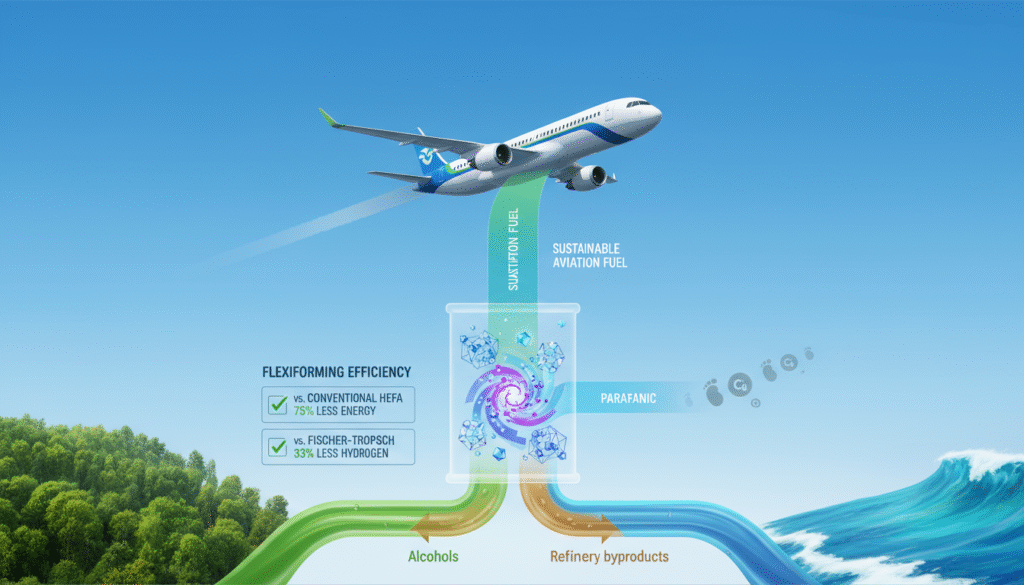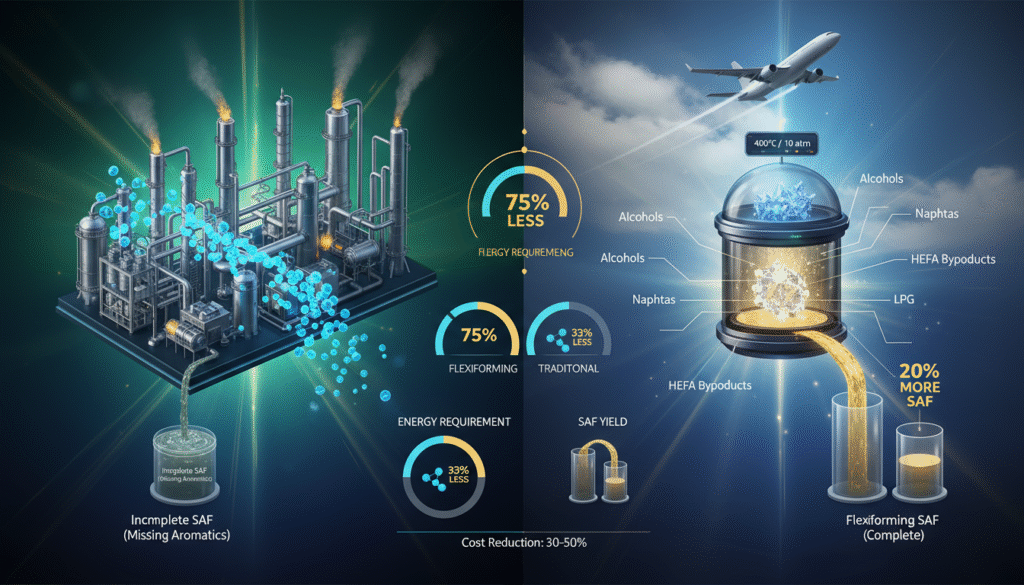Friday, 31 October 2025


In an exclusive AgroSpectrum interview, Alexei Beltyukov, CEO and Co-founder of Universal Fuel Technologies (Unifuel), elucidates how the company’s proprietary Flexiforming process transcends the constraints of conventional waste-oil-based biofuels, converting alcohols and low-value refinery byproducts into truly drop-in Sustainable Aviation Fuel (SAF). By delivering the elusive aromatic fraction required for jet engine performance — something HEFA and Fischer–Tropsch routes cannot independently supply — Unifuel simultaneously augments yield and slashes both energy and hydrogen inputs.
Beltyukov underscores that Flexiforming’s modularity and compatibility with existing refineries and ethanol facilities offer a capital-efficient scale-up pathway at a time when the SAF markets are beleaguered by feedstock scarcity and punishing production costs. Policy acceleration toward 100 per cent synthetic SAF approval, coupled with long-term airline offtake agreements, he argues, will unlock the confidence necessary for global deployment. Ultimately, Unifuel positions itself not as a solitary panacea but as a catalytic enabler of a commercially viable, climate-positive aviation future, where complementary pathways collaborate to maximise every molecule of renewable carbon.
I. Technology & Production
From Waste to Jet Fuel:

Can you explain the core technology behind Unifuel’s conversion of waste oils and fats into SAF, and what differentiates it from conventional biofuel pathways?
Unifuel doesn’t directly convert waste oils and fats into SAF. Rather, our Flexiforming technology complements existing processes that do. We convert alcohols like ethanol and methanol into high-quality SAF, and we upgrade the low-value byproducts—naphtha and LPG—from Hydroprocessed Esthers and Fatty Acids (HEFA) and Fischer-Tropsch (FT) processes that use waste oils and fats.
The key differentiator is our single-step, all-gas phase reaction using a proprietary catalyst. This design reduces energy consumption by 75 per cent and hydrogen requirements by 33 per cent compared to alternative ethanol-to-jet processes, positioning our technology at approximately half the cost. Additionally, we produce aromatic SAF components that HEFA and Fischer-Tropsch cannot, which are essential for jet engine performance and achieving true drop-in capability.
Performance and Sustainability:

How do Unifuel’s SAF products perform in terms of energy density, combustion efficiency, and lifecycle carbon intensity compared to fossil-based jet fuels?
Flexiforming produces SAF that is chemically comparable to conventional jet fuel, containing the 8-25 per cent aromatics that today’s aircraft engines require. Our SAF has undergone comprehensive testing at Washington State University’s Bioproducts, Sciences, and Engineering Lab—the world-leading authority on SAF research—and has been accepted into the ASTM D4054 Clearinghouse for qualification. This acceptance demonstrates that our fuel meets strict quality and safety criteria and shows strong potential for completing the ASTM qualification process successfully.
In terms of lifecycle carbon intensity, depending on the specific chemical pathway, our energy-efficient process has a carbon intensity 10-31 per cent that of the incoming feedstock—a significant reduction beyond the inherent benefits of using renewable feedstocks.
II. Scaling Challenges
Feedstock Constraints:
Waste oils and fats are finite and geographically dispersed. What strategies is Unifuel pursuing to secure a consistent, scalable feedstock supply, and how do logistics impact production economics?

Rather than competing for limited HEFA feedstocks, our strategy is to make the best of what’s available and diversify. For example, for HEFA—indeed, a feed-limited pathway to SAF—Flexiforming can convert their low-value byproduct, naphtha, into the aromatic component of SAF. Apart from making the product a potentially fully synthetic fungible jet fuel (subject to ASTM approvals), this produces 20 per cent more SAF from the same amount of feedstock. Flexiforming works with any alcohol or ether, renewable naphthas, and LPG. This versatility allows plant operators to adapt to feedstock availability and pricing fluctuations.
For ethanol specifically, we see significant opportunity. The U.S. already produces billions of gallons of ethanol annually for gasoline blending. As electric vehicles replace gasoline-powered cars, this ethanol can be redirected to jet fuel production without impacting food production or requiring new agricultural investment. Flexiforming offers ethanol plant operators an economically viable ethanol-to-jet pathway, 50 per cent less expensive than existing ETJ options.
Refinery and Conversion Economics:
What are the key technical and economic bottlenecks in scaling SAF production from laboratory or pilot-scale to commercial refinery operations, and how is Unifuel addressing them ?

The primary bottlenecks are cost (SAF currently costs 2 to 4 times more than conventional jet fuel) and feedstock limitations. Our single-reactor design dramatically reduces capital and operational costs. Flexiforming is also designed for scalable deployment at various sizes, from small bolt-on units for Fischer-Tropsch plants to large refinery-scale installations. This flexibility allows producers to match their investment to their specific circumstances rather than requiring massive upfront capital. Critically, we integrate with existing infrastructure, minimizing deployment costs and accelerating time to market. Our successful 2024 five-month pilot campaign demonstrates we’ve moved beyond laboratory concepts closer to commercially proven, reproducible technology.
III. Policy & Market Dynamics
Regulatory Alignment:

How do government incentives, blending mandates, and carbon credit schemes influence SAF adoption, and where do you see regulatory gaps that need urgent attention to accelerate deployment ?
Similar to how EVs initially depended on government incentives before becoming mainstream, SAF needs policy support to offset the current cost premium and give producers confidence to invest.
The next step we are awaiting in the regulatory area is the adoption of a standard for 100 per cent drop-in, fully synthetic SAF. Currently, ASTM standards allow most SAF to be blended with conventional jet fuel up to 50 per cent . The industry anticipates approval for 100 per cent synthetic SAF by the end of 2026, but this requires addressing the aromatics requirement—something HEFA and Fischer-Tropsch alone cannot provide.
Technologies that can produce aromatic SAF components should receive accelerated regulatory review and support, as they’re essential for eliminating the need for continued blending with fossil fuels.
Global Market Readiness:
With airlines increasingly committing to SAF targets, what is your perspective on the readiness of global supply chains and airport infrastructure to handle large-scale SAF integration?

Infrastructure is largely in place to support greater use of SAF, since it is a “drop-in” replacement that works with today’s aircraft. Once the fully synthetic SAF standard is adopted, common-carrier pipelines and all other infrastructure will be accessible to SAF. The real challenge is scaling production to meet growing demand. SAF currently represents less than 1 per cent of global jet fuel consumption, and closing that gap will depend on both technologies that make existing production pathways more efficient and cost-effective, as well as the regulatory approach.
A lot of capacity and feedstock that can be used to make SAF are presently targeting renewable diesel. This is a partial result of how the tax incentives are set up, and also of the fact that when making SAF, the producers inevitably make significant quantities of naphtha – a byproduct that, in the absence of Flexiforming, has a relatively low value.
Flexiforming helps in exactly that way. By upgrading low-value byproducts such as naphtha and LPG into additional SAF, our technology enables producers to generate more fuel from the same feedstock. This increases total output while improving project economics, which in turn helps airlines and fuel suppliers meet their sustainability commitments more quickly and affordably.
IV. Strategic Outlook
Investment and Partnership Models:

What role do strategic airline partnerships, venture capital, and private equity play in enabling SAF scale-up, and what frameworks have you found most effective for attracting long-term investment?
Strategic partnerships are critical, especially between technology providers, fuel producers, and airlines. Airlines’ long-term offtake agreements provide the demand certainty investors look for, while venture and private equity partners can fund early deployment.
Unifuel’s model is based on technology licensing rather than direct fuel production, which makes scaling faster and more capital-efficient. Our customers can integrate Flexiforming into their existing plants with relatively low CapEx, creating a more distributed, resilient SAF supply network. This model appeals to investors because it allows them to participate across multiple facilities and feedstocks, reducing risk while accelerating market penetration.
Beyond Waste Oils:
As SAF demand grows, how is Unifuel preparing for feedstock diversification — for example, algae, municipal waste, or other renewable sources — and what technical or economic hurdles remain in that transition ?

Feedstock diversification is at the heart of Flexiforming’s value proposition. We can already process any naphtha, alcohol or ether, so as new pathways to these feeds emerge—from algae, cellulosic sources, or other biomass—we can potentially integrate them.
For municipal and agricultural waste, we complement Fischer-Tropsch processing. By upgrading FT’s naphtha and LPG byproducts into aromatic SAF, we can increase plant revenue by 10-20 per cent, making waste-to-SAF projects more financially viable.
The main challenge is not chemistry, but logistics and preprocessing costs. That’s why our technology can be deployed at different scales, even near the source of biomass or waste conversion. By enabling modular, regional SAF production, Flexiforming helps producers reduce transportation costs and make better use of local renewable resources.
Vision for Net-Zero Aviation:
Looking ahead 5–10 years, how do you see Unifuel contributing to a commercially viable, climate-positive aviation sector, and what are the key milestones the industry must hit to achieve that vision?

We envision three major use cases: bolt-ons to Fischer-Tropsch and HEFA plants processing waste feedstocks; partnerships with ethanol plants transitioning from selling ethanol for gasoline blending to SAF; and retrofitting existing oil refineries for SAF production.
The key industry milestones include ASTM approval for 100 per cent drop-in synthetic SAF by end of 2026; achieving economic parity or near-parity with conventional jet fuel through technology improvements and policy support; and successfully diversifying beyond limited HEFA feedstocks.
Our goal is for Flexiforming to become a mainstream enabling technology—recognizing that no single pathway will meet 100 per cent of demand, but that complementary technologies working together can maximize resource utilization and make sustainable aviation the norm rather than the exception.
—- Suchetana Choudhury (suchetana.choudhri@agrospectrumindia.com)